ISSN ONLINE(2319-8753)PRINT(2347-6710)
ISSN ONLINE(2319-8753)PRINT(2347-6710)
K B Siddegowda1 and J Venkatesh2
|
| Related article at Pubmed, Scholar Google |
Visit for more related articles at International Journal of Innovative Research in Science, Engineering and Technology
Experimental investigation has been carried out on MPFI engine to study the effects of gasoline-ethanol blends on lubricating properties. For any four stroke engine the function of engine lubricants play an important role since the lubricants does not burn along with fuel in the combustion chamber as two stroke engine. The lubricant will circulate around inside the engine and its quality decreased time b y time. Basically the functions of engine lubricants are prevent wear from friction and keep the engine cool. The performance of engine lubricants is to reduce friction, oxidation, minimize deposit formation and prevent corrosion and wear. In this experimental study of gasoline and gasoline-ethanol blends like 10, 20, 30, by volume compared with results gasoline and gasoline ethanol blends. The lubricating properties examined in the assessment work lubricating capacity, viscosity, stability of oxidation, foaming charactes, carbon residue and flash point , kinematic viscosity and iron content are lower than gasoline run engine can be effectively used with E20. The lubricating properties are examined by AAS and IS standards.
Keywords |
| MPFI engine, gasoline-ethanol blends, lubricating oil, viscosity |
INTRODUCTION |
| When one surface moves over other there is always some resistance to movement. The force that opposes movement called friction. Generally lubricant is to reduce friction like metal rolling, and elimination of brake and clutch in the car. The lubricating system provides oil as a film between the moving parts of the engine to prevent wear from friction and to keep the engine cool. Lubricating oil should provide the film of proper thickness between the moving surfaces under all conditions of operations remains stable under changing temperature conditions and not to corrode the metal surface [6]. Apart from lubrication engine oil lubricating moving parts, also cleans inhibits corrosion, improves sealing and cools the engine by carrying heat away from moving parts [3].The environment in which it operates affects lubricant stability such factors as temperature, oxidation, potential and contamination with water, unburnt fuel fragments corrosive acid limits the useful life of the lubricant [6]. |
| The lubricant consists mainly of base oil and chemical additives which are blended according to its grade and specific duty. When adjusted optimally to its task wear and maintenance requirements can be reduced leading to a standard. The reality is that the majority of engines that use low percentage of ethanol blends are designed to run on gasoline. The objective of this research was to determine the effect of ethanol blends and performance and properties of lubricants on MPFI engine. Experimental tests were performed on MPFI engine using pure gasoline and different ethanol blends like 10%, 20%, and 30% blends. The results of the study show that 20% ethanol blends can be used in MPFI engines without any negative drawbacks. The CO and HC emissions are greatly reduced; CO2 emissions are increased due to increased combustion. The lubricating oil used in pure gasoline the same oil may be used in gasohol. Table.1 shows the properties of typical gasoline used as I.C. engine fuel and ethanol. |
PRODUCTION OF ETHANOL |
| As the main intention of using alternative fuels is to save gasoline, it must be obtained from non-petroleum products. Ethanol can be easily manufactured from non-petroleum products such as sugarcane, corn, timber and other cellulose wastes. India being an agro – based country is having good prospects of producing sugarcane. Production of ethanol from sugarcane requires only simple, well – established processes since the fermentable sugar is obtained directly from sugarcane.The cane is first cut and ground, and the cane juice is extracted by maceration. After clarification by filtration and concentration through evaporation, the juice is fermented with yeast to yield raw ethanol. A series of distillation steps, including a final extractive distillation with benzene are used to obtain anhydrous ethanol. Ethanol is produced by fermentation of carbohydrates by the Gay Lussac relation. In this process 180 gram of ethanol of carbohydrates are converted to liquid fuel weighing only 92 gram with almost no loss of energy. Figure 2.3.1 shows schematically the conversion of sugarcane to ethanol in a sugar factory via the molasses route. Such manufacturing plants of ethanol can easily be set up along with sugar factory to utilize raw product of sugar factory called molasses. In fact, there are such plants installed in western Maharashtra at Sangli, Satara and Solapur districts. |
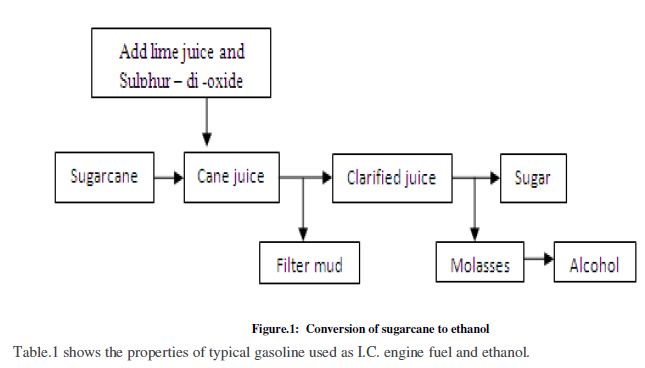 |
EXPERIMENTAL SETUP AND TESTING |
| The test has to be conducted in three stages for both petrol and ethanol-petrol blend. Each stage is of 6 hr duration. Each stage consists of 5 modes. The first mode is the idle period in which the engine is kept for five min idling so that the engine warms up properly and the engine reach its operating temperature and the circulation of the lubricating oil is proper. In the second mode, the engine is made to run for 1hr55min under constant speed of 2000 rpm and varying load from 0-8 Kg in steps of 2Kg. In other words we are making the engine to run at 50kmph speed which under economic zone as by Maruti manufacturer specification. For each load the engine is made to run for 23min each. The various parameters such as lubricating oil temperature, water inlet temperature, water outlet temperature, amount of fuel consumed per minute, CO, HC emission reading etc are taken into consideration and readings are taken. In the third mode, the engine is made to run for two hour under constant speed of 3000rpm and constant load of 8Kg. In terms of kmph the engine is made to run at 70kmph speed. The readings of the various parameters as mentioned above should be taken. Again, in the fourth mode, the engine is made to run for 45min under constant speed of 3500 rpm and constant load of 10 Kg. In terms of kmph the engine is made to run at 85 kmph speed and various readings are taken. In the fifth mode, the engine is run for 50 min. under constant speed of 2500 rpm and gradually decreasing load from 8Kg to 0 Kg. For each load the engine is made to run for 10min each in terms of kmph the engine is made to run at 60kmph. |
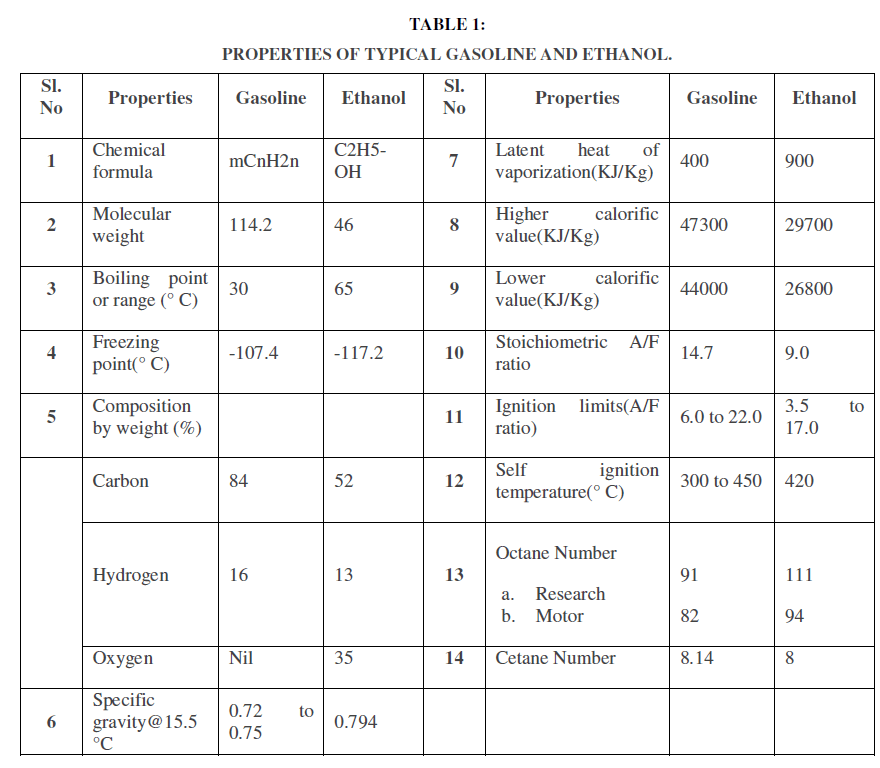 |
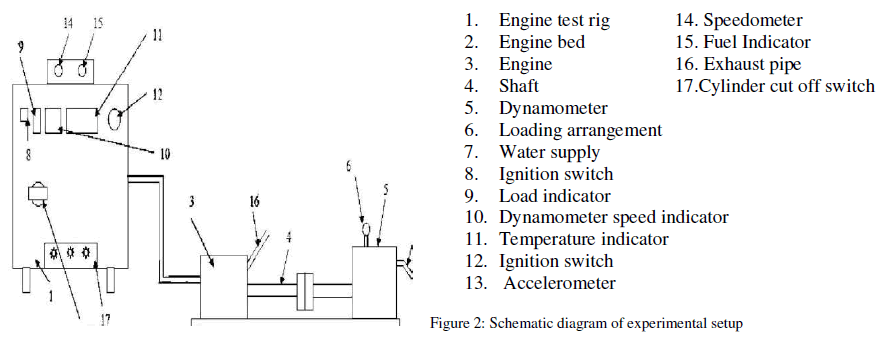 |
RESULTS AND DISCUSSION |
A. TOTAL FUEL CONSUMPTION |
| Figure 3 & Figure 4 shows the variation of total fuel consumption verses brake horse power for 100% gasoline and E-20 run engine at 2000 and 2500 rpm speed of the engine. It is seen from the graph that at low and moderate load conditions the fuel consumption with gasoline as a fuel is comparatively lower than that of E20. This is because a gallon of ethanol contains less than 2/3 of the energy of a gallon of petrol. Hence the volumetric fuel economy decreased slightly with E-20 in comparison with 100% gasoline run engine. |
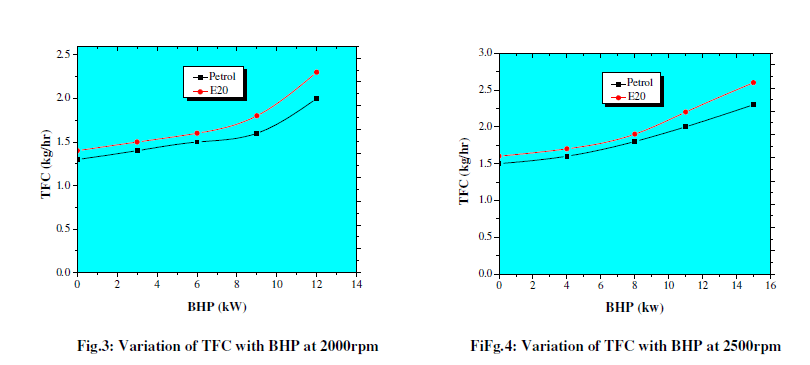 |
B. SPECIFIC FUEL CONSUMPTION |
| Fig.5 & Fig.6 shows the plot between the specific fuel consumption (SFC) verses brake horse power for 100% gasoline and 20% ethanol- 80% gasoline blend (E-20) at two different engine speed. From the graph, it is seen that the SFC of the engine with E-20 is more than that of an engine run with 100% gasoline or in other words, for generating equal amount of energy (BHP) greater weight of E-20 is required as compared to 100% gasoline. This is because the stoichiometric air-fuel ratio required for ethanol is 9:1 which is considerably lower than that required for petrol (14.7:1), also the calorific value (CV) of ethanol is lower than that of petrol. To generate equal amount of energy, approximately 64% greater weight of ethanol is required as compared to petrol. Hence for E20 also the SFC is slightly more in comparison to 100% gasoline, however energy based economy increased using ethanol gasoline blend because of the increase in octane number of the ethanol- gasoline blend due to which the combustion characteristics are improved and consequently proper and effective burning of the fuel. |
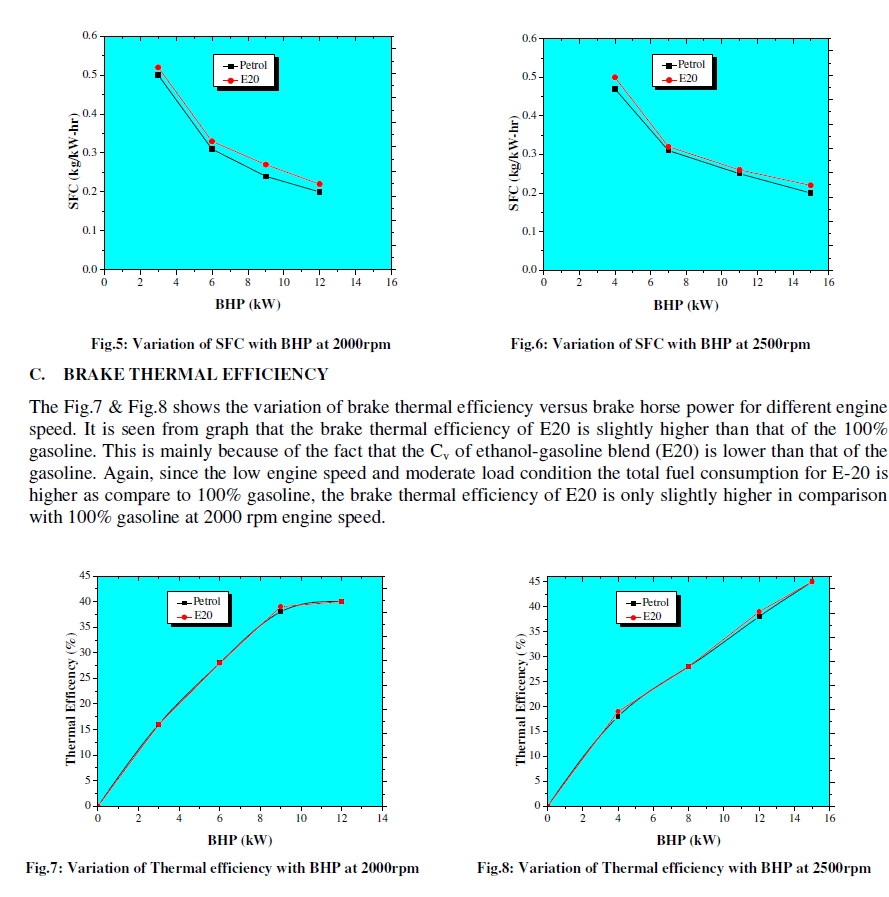 |
D. MECHANICAL EFFICIENCY |
| Fig.9 shows the variation of mechanical efficiency in percentage verses load in kg for E-20 and 100% gasoline. From the graph it is seen that the mechanical efficiency of E-20 fuel engine is always in higher side than that of the gasoline engine. At all load conditions the mechanical efficiency of E-20 is higher than that of 100% gasoline. It is also seen from the graph that the differences in the values of mechanical efficiency are higher at higher load condition. |
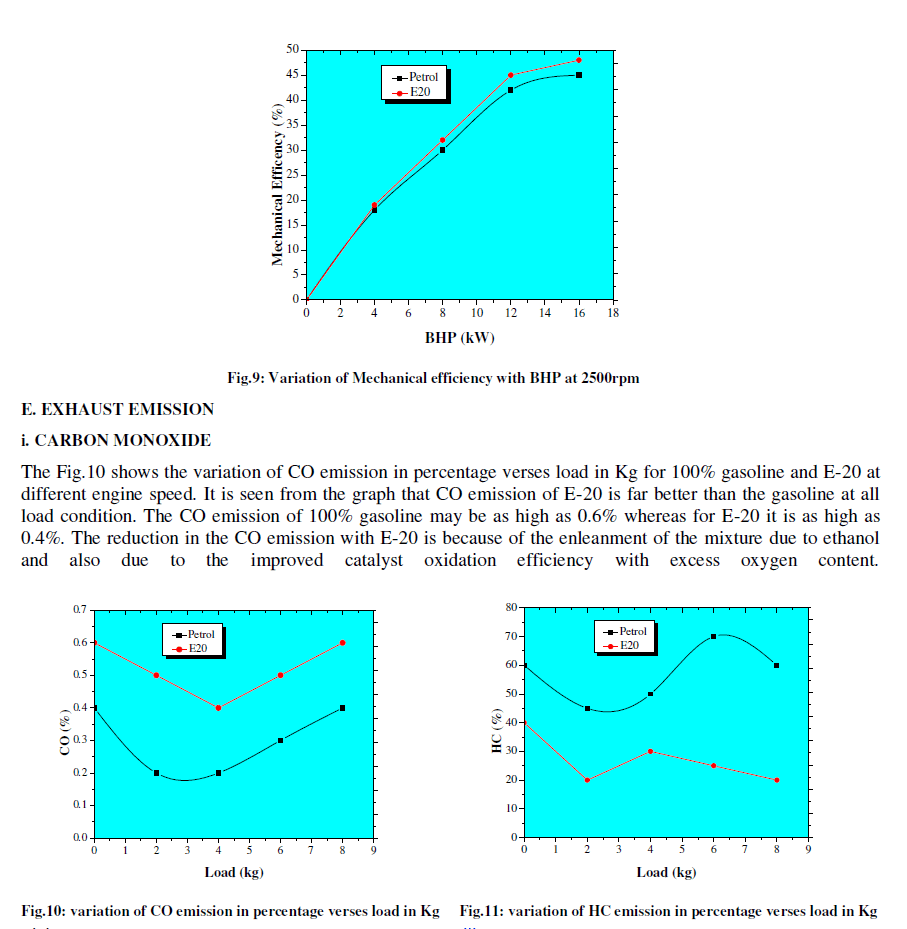 |
ii. HYDRO CARBON |
| The Fig.11 shows the variation of HC emission (in ppm) verses load for 100% gasoline and E-20 respectively. From the graph it is seen that the HC emission for E20 is greatly reduced in comparison to 100% gasoline. This is because of the fact that addition of ethanol improves the octane number of the fuel due to which the fuel will burn more completely resulting in lesser unburned HC emission. |
CONCLUSION |
| • One can run the engine efficiently and economically with ethanol gasoline blend(E20) as engine fuels for SI engines. |
| • Alcohols are basically not suitable for C.I engine operation, because of their lower cetane number. |
| • Use of alcohol-gasoline blend improves start ability because of increase in octane number of fuel due to addition of alcohol into gasoline. |
| • The high octane number of alcohols compared to gasoline means higher compression ratio can be used, which results in higher engine efficiency and higher power from engine. |
| • Existing engine cannot be run with straight alcohol, because the engine needs certain modification in the fuel supply system. |
| • Use of ethanol-gasoline blend (E20) as an engine fuel results in lesser CO emissions compared to gasoline. |
| • Fuel consumption is slightly increased by using ethanol-gasoline blend (E20) as compared to gasoline. |
| • Specific fuel consumption is slightly higher for E20. This means that the volumetric fuel economy is decreased whereas energy wise fuel economy is increased. |
| • Brake thermal efficiency of the engine using gasoline ethanol blend is considerably more than that of the engine using gasoline alone as fuel. |
| • Mechanical efficiency of the engine using gasoline ethanol blend is considerably more than that of the engine using gasoline alone as a fuel. |
| • Use of ethanol gasoline blend (E20) results in lesser HC emission compared to gasoline. |
| • The lubricating oil used for gasoline run engine can be effectively used with E20. |
References |
|